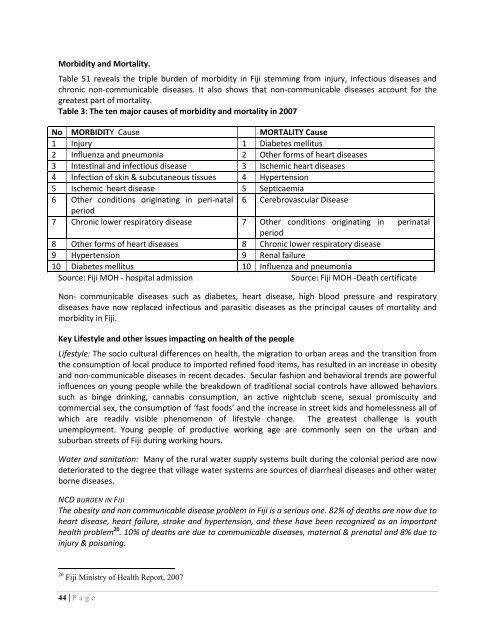Project Report â Fiji 2010 - Pacific Health Voices
Project Report â Fiji 2010 - Pacific Health Voices
Project Report â Fiji 2010 - Pacific Health Voices
You also want an ePaper? Increase the reach of your titles
YUMPU automatically turns print PDFs into web optimized ePapers that Google loves.
Morbidity and Mortality.<br />
Table 51 reveals the triple burden of morbidity in <strong>Fiji</strong> stemming from injury, infectious diseases and<br />
chronic non-communicable diseases. It also shows that non-communicable diseases account for the<br />
greatest part of mortality.<br />
Table 3: The ten major causes of morbidity and mortality in 2007<br />
No MORBIDITY Cause MORTALITY Cause<br />
1 Injury 1 Diabetes mellitus<br />
2 Influenza and pneumonia 2 Other forms of heart diseases<br />
3 Intestinal and infectious disease 3 Ischemic heart diseases<br />
4 Infection of skin & subcutaneous tissues 4 Hypertension<br />
5 Ischemic heart disease 5 Septicaemia<br />
6 Other conditions originating in peri-natal 6 Cerebrovascular Disease<br />
period<br />
7 Chronic lower respiratory disease 7 Other conditions originating in perinatal<br />
period<br />
8 Other forms of heart diseases 8 Chronic lower respiratory disease<br />
9 Hypertension 9 Renal failure<br />
10 Diabetes mellitus 10 Influenza and pneumonia<br />
Source: <strong>Fiji</strong> MOH - hospital admission<br />
Source: <strong>Fiji</strong> MOH -Death certificate<br />
Non- communicable diseases such as diabetes, heart disease, high blood pressure and respiratory<br />
diseases have now replaced infectious and parasitic diseases as the principal causes of mortality and<br />
morbidity in <strong>Fiji</strong>.<br />
Key Lifestyle and other issues impacting on health of the people<br />
Lifestyle: The socio cultural differences on health, the migration to urban areas and the transition from<br />
the consumption of local produce to imported refined food items, has resulted in an increase in obesity<br />
and non-communicable diseases in recent decades. Secular fashion and behavioral trends are powerful<br />
influences on young people while the breakdown of traditional social controls have allowed behaviors<br />
such as binge drinking, cannabis consumption, an active nightclub scene, sexual promiscuity and<br />
commercial sex, the consumption of ‘fast foods’ and the increase in street kids and homelessness all of<br />
which are readily visible phenomenon of lifestyle change. The greatest challenge is youth<br />
unemployment. Young people of productive working age are commonly seen on the urban and<br />
suburban streets of <strong>Fiji</strong> during working hours.<br />
Water and sanitation: Many of the rural water supply systems built during the colonial period are now<br />
deteriorated to the degree that village water systems are sources of diarrheal diseases and other water<br />
borne diseases.<br />
NCD BURDEN IN FIJI<br />
The obesity and non communicable disease problem in <strong>Fiji</strong> is a serious one. 82% of deaths are now due to<br />
heart disease, heart failure, stroke and hypertension, and these have been recognized as an important<br />
health problem 20 . 10% of deaths are due to communicable diseases, maternal & prenatal and 8% due to<br />
injury & poisoning.<br />
20 <strong>Fiji</strong> Ministry of <strong>Health</strong> <strong>Report</strong>, 2007<br />
44 | P a g e
















